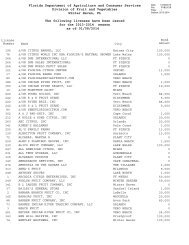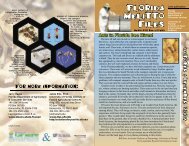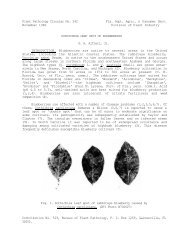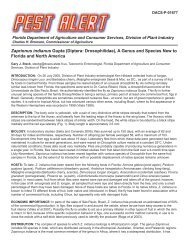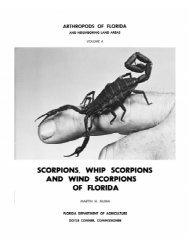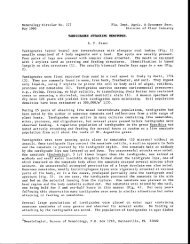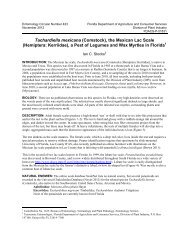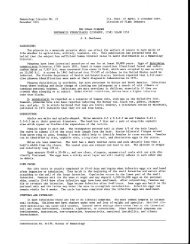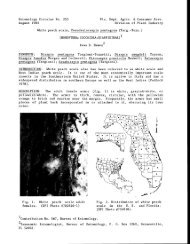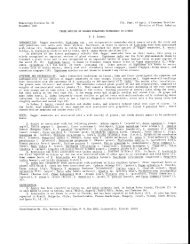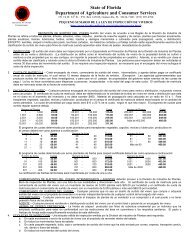A Checklist of the Beetles of Cuba with Data on Distributions and ...
A Checklist of the Beetles of Cuba with Data on Distributions and ...
A Checklist of the Beetles of Cuba with Data on Distributions and ...
You also want an ePaper? Increase the reach of your titles
YUMPU automatically turns print PDFs into web optimized ePapers that Google loves.
20<br />
Arthropods <str<strong>on</strong>g>of</str<strong>on</strong>g> Florida <strong>and</strong> Neighboring L<strong>and</strong> Areas, Vol. 18<br />
Table 7. Genera <str<strong>on</strong>g>with</str<strong>on</strong>g> 10 or more endemic species, showing significant speciati<strong>on</strong> <str<strong>on</strong>g>with</str<strong>on</strong>g>in <str<strong>on</strong>g>Cuba</str<strong>on</strong>g>.<br />
Family Genus number <str<strong>on</strong>g>of</str<strong>on</strong>g> Species<br />
Carabidae Platynus 14<br />
Staphylinidae Osorius 15<br />
Scarabaeidae Phyllophaga (Cnemarachis) 68<br />
Anoplosiagum 15<br />
Lampyridae Callopisma 12<br />
Photinus 11<br />
Tenebri<strong>on</strong>idae Diastolinus 20<br />
Lobopoda 18<br />
Cyrtosoma 13<br />
Str<strong>on</strong>gylium 11<br />
Cerambycidae Elaphidi<strong>on</strong> 29<br />
Leptostylus 10<br />
Chrysomelidae Lema 18<br />
Cryptocephalus 62<br />
Pachybrachis 16<br />
Chlamisius 12<br />
Metachroma 28<br />
Leucocera 11<br />
Oedi<strong>on</strong>ychus 12<br />
Stoiba 11<br />
Anthribidae Tropideres 15<br />
Curculi<strong>on</strong>idae Lachnopus 30<br />
Exophthalmus 20<br />
C<strong>on</strong>otrachelus 10<br />
Anth<strong>on</strong>omus 20<br />
Acalles 12<br />
Pseudomus 11<br />
Cryptorhynchus 37<br />
been through <str<strong>on</strong>g>the</str<strong>on</strong>g> air by wind <strong>and</strong> flight, <strong>on</strong> <str<strong>on</strong>g>the</str<strong>on</strong>g> sea<br />
surface by rafting <strong>on</strong> floating materials, <strong>and</strong> by<br />
being transported by o<str<strong>on</strong>g>the</str<strong>on</strong>g>r animals such as birds.<br />
Such movements were likely most frequent in <str<strong>on</strong>g>the</str<strong>on</strong>g><br />
past during times <str<strong>on</strong>g>of</str<strong>on</strong>g> Pleistocene c<strong>on</strong>tinental glaciati<strong>on</strong>,<br />
when sea levels were lower than at present,<br />
<strong>and</strong> <str<strong>on</strong>g>the</str<strong>on</strong>g> margins <str<strong>on</strong>g>of</str<strong>on</strong>g> surrounding isl<strong>and</strong>s <strong>and</strong> c<strong>on</strong>tinents<br />
were closer to <str<strong>on</strong>g>Cuba</str<strong>on</strong>g> than now.<br />
Introduced species.<br />
A significant number <str<strong>on</strong>g>of</str<strong>on</strong>g> species <str<strong>on</strong>g>of</str<strong>on</strong>g> beetles (86<br />
are presently recognized) have undoubtedly been<br />
brought to <str<strong>on</strong>g>Cuba</str<strong>on</strong>g> through ei<str<strong>on</strong>g>the</str<strong>on</strong>g>r <str<strong>on</strong>g>the</str<strong>on</strong>g> intenti<strong>on</strong>al or<br />
accidental acti<strong>on</strong>s <str<strong>on</strong>g>of</str<strong>on</strong>g> humans. Table 8 lists <str<strong>on</strong>g>the</str<strong>on</strong>g> species<br />
presently thought to be introduced to <str<strong>on</strong>g>Cuba</str<strong>on</strong>g>.<br />
Many <str<strong>on</strong>g>of</str<strong>on</strong>g> <str<strong>on</strong>g>the</str<strong>on</strong>g>se originate in <str<strong>on</strong>g>the</str<strong>on</strong>g> Old World, <strong>and</strong> many<br />
are important pests <str<strong>on</strong>g>of</str<strong>on</strong>g> agricultural crops, trees, <strong>and</strong><br />
stored products. The number <str<strong>on</strong>g>of</str<strong>on</strong>g> introducti<strong>on</strong>s <str<strong>on</strong>g>of</str<strong>on</strong>g><br />
such pests will c<strong>on</strong>tinue to grow <str<strong>on</strong>g>with</str<strong>on</strong>g>out efforts to<br />
prevent this.<br />
Caribbean Insect Biogeography<br />
The West Indies are am<strong>on</strong>g <str<strong>on</strong>g>the</str<strong>on</strong>g> world’s biologically<br />
most important isl<strong>and</strong> groups. <str<strong>on</strong>g>Cuba</str<strong>on</strong>g> is <str<strong>on</strong>g>the</str<strong>on</strong>g><br />
largest isl<strong>and</strong> in <str<strong>on</strong>g>the</str<strong>on</strong>g> West Indies. It lies in <str<strong>on</strong>g>the</str<strong>on</strong>g> midst<br />
<str<strong>on</strong>g>of</str<strong>on</strong>g> o<str<strong>on</strong>g>the</str<strong>on</strong>g>r isl<strong>and</strong>s or isl<strong>and</strong> groups (Bahamas,



